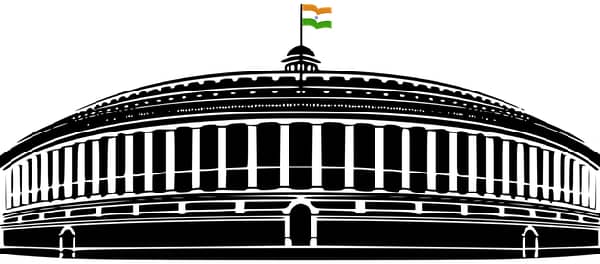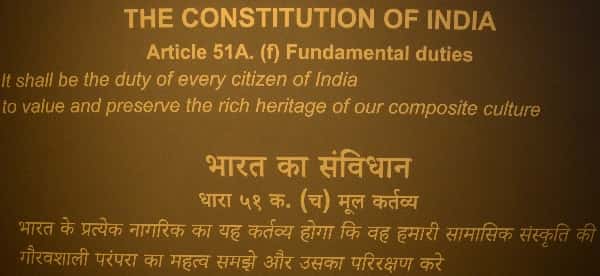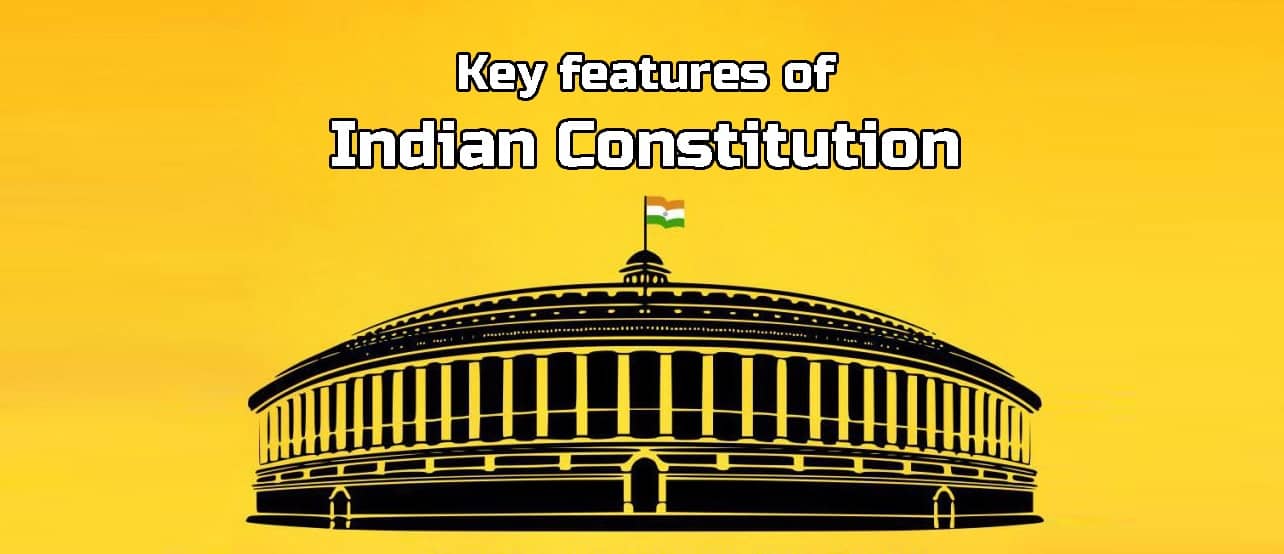Indian Constitution is the Supreme and prime law in our country. Indian Constitution comprises the set of laws, rules, governing principles and norms. In this article, we are sharing key features of Indian Constitution.
Every citizen of India has to abide by the law written in the Indian Constitution. No person can override the rules of the Indian Constitution.
Indian Constitution is the longest written constitution across the globe. B.R. Ambedkar, along with his drafting committee, has framed the supreme Indian Constitution.
The Indian Constitution was framed and passed by Constituent Assembly on 26 November 1949. After 2 months, that is 26 January 1950, the Indian Constitution came into action.
That is the reason India celebrates its Republic Day on 26 January. The day on which the Indian Constitution became the law of the country.
The Indian Constitution has been made by studying several other country’s constitutions. The key features of the Indian Constitution have been adopted from the United Kingdom, United States of America, Russia, Germany, Australia, France, Ireland etc.
Indian Constitution comprises of Preamble, 470 articles, 12 schedules and appendix. It also contains amendments which are changes made to the governing norms.
Key features of the Indian Constitution
-
Lengthiest written Constitution.
Indian Constitution is a very comprehensive, elaborate and detailed document. It is one of the prime key features of the Indian Constitution.
Originally Indian Constitution contained a Preamble, 395 articles and 8 schedules. And presently it contains a Preamble, 470 articles and 12 schedules.
There are four important factors which have contributed to the elephantine size of Indian Constitution.
- Geographic factors and vastness of our country.
- Historical factors and influence of the Government of India Act 1935.
- Single constitution for both centre and state.
- The dominance of legal experts in the Constituent Assembly.
-
Borrowed from various resources
Indian Constitution is borrowed from the constitution of other countries as well as the Government of India Act 1935. Therefore, it is one of the chief key features of Indian Constitution.
Dr B.R. Ambedkar proudly said that the Constitution of India had been framed after ransacking all the well-known constitutions of the world.
The structural part of the Indian Constitution has been derived from the Government of India Act 1935.
The philosophical part that is fundamental rights and directive principles are derived from American and Irish constitution.
The political party has been largely derived from the constitution of the United Kingdom.
Other things are borrowed from Canada, Australia, Germany, Russia, France, South Africa, Japan etc.
-
Combination of Rigidity and Flexibility
A constitution can be both rigid and flexible in nature.
A rigid constitution requires a special procedure for amendments—for example, the constitution of the United States of America.
A flexible constitution can be amended in the same manner as ordinary laws are made—for example, the constitution of the United Kingdom.
Constitution of India is a blend of both, Rigidity and flexibility.
Article 368 provides two types of amendments.
- Some provisions can be amended by a special majority of the parliament that is 2/3rd members of each house must be present and voting and 50 percent of the majority of the total membership of the house.
- Some other provisions can be amended by a special majority of the parliament and with ratification by half of the states.
Therefore, it is one of the main key features of the Indian Constitution.
-
The federal system with Unitary Bias
A federal system with unitary bias is one of the main key features of Indian Constitution.
Constitution of India contains all the usual features of the federation like two governments, division of power, a written constitution, the supremacy of the constitution, the rigidity of constitution, independent judiciary etc.
However, it also contains a large number of unitary or non-federal features.
Features like the strong central, single constitution, single citizenship, the flexibility of constitution, the appointment of state governor by the centre, all India services, emergency provinces etc.
Therefore, the Indian Constitution is referred to as Federal in form but Unitary in spirit or Quasifederal.
Both Federal and non-federal aspects of Indian Constitution make it the main key feature of the Indian Constitution.
-
Parliamentary form of government

The parliamentary form of government is also known as “West minister” model of government, responsible government and cabinet government.
This idea of parliamentary has been borrowed from the British constitution. It is one of the most important key features of the Indian Constitution.
The features of the parliamentary form of government include:
- Presence of nominal and real executives.
- Majority party rule.
- Collective responsibility of the executive to the legislature
- The leadership of Prime Minister or Chief Minister
- Dissolution of the lower house or Lok Sabha.
Indeed, the Parliamentary form of government is the chief key feature of Indian Constitution.
-
Synthesis of Parliamentary, Sovereignty and Judicial Supremacy.
Synthesis or mixture of Parliamentary, Sovereignty and Judicial Supremacy is one of the unique key features of Indian Constitution.
The sovereignty of parliament is associated with the British Parliament while the principle of judicial supremacy is associated with American Supreme court.
The supreme court can declare the parliamentary loss as unconstitutional through its power of judicial review.
The parliament, on the other hand, can amend a major portion of the constitution through its power.
Exercise of power by both parliament and judiciary is equally important for making peace within citizens of the country.
Also Read: Essay on the Constitution of India
-
Integrated and Independent Judiciary
The integrated and independent judiciary are both the parts of coins of Indian judicial system. It is one of the main key features of the Indian Constitution.
Supreme court stands at the top of the integrated judicial system in the country.
Below supreme court, there are High courts at the state level.
Under High court, there are district courts and other lower courts.
This single system of court enforces both central and state laws unlike in the United States of America where federal laws are enforced by federal judiciary, and state laws are enforced by the state judiciary.
The supreme court is the highest court of appeal, the guarantor of the fundamental rights and guardian of the constitution.
Hence, the Indian Constitution has made various provisions to ensure the independence of Judiciary.
- Security of tenure of judges
- Fixed service condition for judges
- All expenses of supreme courts are charged from the consolidated fund of India
- Prohibition on the discussion on the conduct of judges in the legislature
- Ban on practice after retirement
- Power to punish for its contempt.
8. Fundamental rights

Fundamental rights are one of the most important and supreme key features of Indian Constitution.
Part 3 of the Indian Constitution guarantees six fundamental rights to all the citizens.
- Right to Equality (Article 14 to 18)
- Right to freedom (Article 19 to 22)
- Right against exploitation (Article 23,24)
- Right to freedom of religion (Article 25 to 28)
- Cultural and Educational Rights (Article 29, 30)
- Right to Constitutional Remedies (Article 32)
The fundamental rights are meant for promoting the idea of political democracy. They are justiciable in nature that is they are enforceable by the court for their violation.
Fundamental rights are not absolute, and they are subject to reasonable restriction. They can be changed by parliament through constitutional amendment act.
They can be suspended during a national emergency except Article 20 and 21. It is one of the most important key features of Indian Constitution.
-
Directive principles of state policy
According to B.R. Ambedkar directive principles of state, policy is one of the most novel key features of the Indian Constitution.
They can be classified into three broad categories:
- Socialistic
- Gandhian
- Liberal intellectual
They are meant for promoting social and economic democracy. However, the directions are not justiciable in nature. They impose a moral obligation on state authorities for their application.
-
Fundamental Duties

The original constitution did not contain the fundamental duties of a citizen.
This was added in 1975-1977 by the 42nd constitutional amendment act of 1976 on the recommendation of Swarn Singh committee.
Various fundamental duties are as follows:
- To respect the constitution, national flag, national anthem, national song.
- To protect the sovereignty, unity and integrity of the country
- To promote the spirit of common brotherhood
- To preserve the rich heritage of our culture and so on.
The fundamental duties are equally as important as fundamental rights. One should do fundamental duties with at most pride as it is one of the key features of the Indian Constitution.
-
Secular state
The constitution of India stands for a secular state, so it does not uphold any particular religion as the official religion of Indian state.
The term secular was added to the Preamble of Indian Constitution by the 42nd constitutional act of 1976.
The state shall not deny to any person equality before the law (Article 14).
The state shall not discriminate against any citizen on the grounds of religion (Article 15).
Equality of opportunity of all citizens in the matter of public employment (Article 16).
All persons have the right to freely profess, practice and propagate any religion (Article 25).
No person should be compelled to pay any taxes for the promotion of a particular religion (Article 27).
No religious instruction shall be provided in any education institute maintained by the state (Article 28).
All minorities shall have the right to establish and administer educational institution of their choice (Article 30).
There is no doubt that it is one of the main key features of Indian Constitution.
-
Universal Adult Franchise
The Indian Constitution adopts universal adult franchise as a basis of election for Lok Sabha and State Legislative Assembly.
Every citizen who is not less than 18 years of age has the right to vote without any discrimination of caste, race, religion, gender, literacy, wealth and so on.
The voting age was reduced to 18 years from 21 years in 1989 by 61st constitutional amendment act of 1988.
Therefore, it is one of the prime key features of the Indian Constitution.
-
Single citizenship.
Though the Indian Constitution is federal and it has dual polity, it provides only one citizenship that is Indian Citizenship.
In countries like the United States of America, a person has dual citizenship of both states and country.
In India, all citizens irrespective of the state in which they were born to enjoy the same rights without any discrimination except few cases like tribal areas, Jammu and Kashmir.
The concept of single citizenship is one of the cardinal key features of Indian Constitution.
-
Independent bodies.
There are few independent bodies which are independent of government and its norms.
Independent bodies are as follows:
- Election commission
To ensure free and fair elections to the parliament, state legislature, president of India etc.
2. Comptroller and Auditor General of India
CAG that is Comptroller and Auditor General of India to audit the accounts of central and state government.
3. Union Public Service Commission
UPSC or Union Public Service Commission to conduct examinations for recruitment to All India Services.
4.State Public Service Commission
State Public Service Commission in every state to conduct examinations for recruitment to state Services.
Therefore, Independent bodies are one of the main key features of the Indian Constitution.
-
Emergency provisions
The Indian Constitution contains elaborate emergency provisions to enable the president to handle any extraordinary situation effectively.
National emergency on the ground of war or external aggression or armed rebellion.
State emergency (President’s rule) on the ground of failure of constitutional machinery in the state (Article 356) or failure to comply with the direction of centre (Articleb365).
Financial emergency on the ground of threat to financial stability or credit of India (Article 360).
During the emergency, the central government becomes all-powerful and states go into total control of the centre.
It converts federal structure into unitary. As emergency provisions are the case of extreme, the government cannot declare it easily without the consent of states.
This kind of transformation is one of the unique key features of Indian Constitution.
-
3-tier government
Originally Indian Constitution provided dual polity with regards to centre and state.
Later 73rd and 74th constitutional amendment act 1992 have added a third tier of government that is local government.
Local government or the 3-tier government is not found in any other constitution of the world.
It gave recognition to Panchayats that Rural local governments and municipalities that is Urban local government by adding schedule 11 and schedule 12.
Being the most unique, it is one the main key features of the Indian Constitution.
There are other key features of Indian Constitution as well, which are not listed here. But these are the prime and foremost key features of the Indian Constitution.
Indeed, the Indian Constitution is well written and has unique features, but it also has some criticism. Being so elephantine size, it is a paradise for lawyers.
But since it is the supreme law of the nation, every citizen has to compulsory abide by it.
